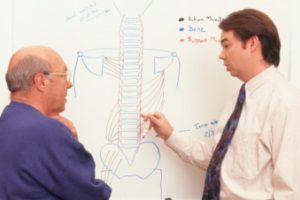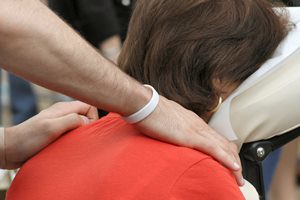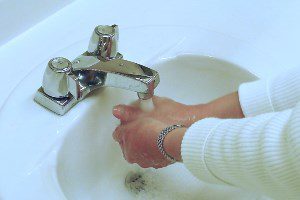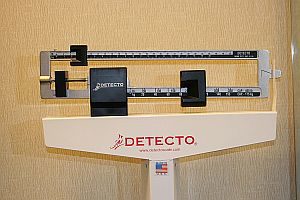What Are “Manual Therapies” and How Are They Used?
 Manual therapies have been used to treat musculoskeletal disorders for thousands of years. Practitioners around the world—in countries with many different cultural influences and diverse medical traditions—have used their hands to manipulate various parts of the body to stimulate healing. “Manual” literally means “by hand.” Thus, manual therapies consist of healing techniques that use the hands. There are more than two dozen techniques used worldwide. Among the most commonly known are acupressure, chiropractic, massage therapy, physiotherapy, reflexology, Rolfing and shiatsu.
Manual therapies have been used to treat musculoskeletal disorders for thousands of years. Practitioners around the world—in countries with many different cultural influences and diverse medical traditions—have used their hands to manipulate various parts of the body to stimulate healing. “Manual” literally means “by hand.” Thus, manual therapies consist of healing techniques that use the hands. There are more than two dozen techniques used worldwide. Among the most commonly known are acupressure, chiropractic, massage therapy, physiotherapy, reflexology, Rolfing and shiatsu.
There are also dozens of other, lesser-known manual therapies, including the Bowen technique, cranio-sacral therapy, the Dorn method, manual lymphatic drainage, muscle energy technique, myofascial release, myotherapy, naprapathy and zero balancing. We examine the most common therapies here:
Acupressure
Using the hand, the elbow or various devices, an acupressure practitioner applies a light force on various parts of the body following the patterns found in traditional Chinese medicine and acupuncture. More than half of the scientific studies on acupressure showed that this technique was effective, but some critics have claimed “a significant likelihood of bias.”
Chiropractic
Most chiropractic work involves manipulation of the spine to achieve better vertebral alignment. Lower back pain is perhaps the primary complaint which leads patients to a chiropractor. Chiropractors are expert at treating musculoskeletal conditions without the use of drugs or surgery. Among others, many top athletes swear by their chiropractor’s hands to keep them performing at their best and help them avoid injuries.
Massage Therapy
This is perhaps the oldest of the manual therapies. Massage was (and still is) used in ancient Egypt, China, Mesopotamia, and other parts of the world that gave rise to early civilizations. Massage practitioners chiefly use their hands, but also other parts of their body to apply pressure, rolling motions and other techniques to muscles and joints, to stimulate circulation and relax the patient. In today’s high-stress world, massage is proving ever more popular.
Physiotherapy
Physiotherapy has been used for years as standard treatment for patients suffering from musculoskeletal conditions. A physical therapist uses a variety of techniques to help their patients regain function—particularly mobility. Repetitive, assisted motion can help the patient strengthen muscles that have been damaged through injury or disease. Assisting the patient in the performance of targeted exercises can help a patient regain greater range of motion.
Reflexology
A trained reflexologist applies pressure to various parts of the feet, hands or ears to stimulate organs within the body associated with the part to which pressure is being applied. It is a Chinese therapy with a philosophy that is similar to acupuncture—using points on the body to restore energy flow. Although there is not yet much scientific evidence to support its effectiveness, anecdotal evidence shows that patients are happier and more relaxed after treatment.
Rolfing Structural Integration
Rolfing specifically targets the body’s connective tissue to release tension, realign and balance the body. Rolfing techniques involve deep-tissue massage to achieve therapeutic benefits such as better posture and greater freedom of movement, including reducing stress and relieving pain.
Shiatsu
A traditional Japanese therapy, the term Shiatsu means “finger pressure,” but can include palm pressure and other approaches to massage. A Shiatsu practitioner uses touch, comfortable pressure and manipulative techniques on specific points of the body (similar to the meridians of Traditional Chinese Medicine) to adjust the body’s physical structure and balance its energy flow. Anecdotal evidence shows it to relieve patients of stress, nausea, muscle pain, depression and anxiety.
 We are sharing an article today that was first run in the Billings Gazette in 2014. We think it has some good information and we have added a few tips of our own at the conclusion of the article:
We are sharing an article today that was first run in the Billings Gazette in 2014. We think it has some good information and we have added a few tips of our own at the conclusion of the article:

 What do you think about when you hear the word “massage”? If you’re like many people, you associate massage with a day of pampering at an exclusive resort spa in the mountains or at the beach. But if that’s the first picture that comes to mind, you might be missing something very, very important. That something is the therapeutic value of massage—the ways that massage can actually improve your health and well-being.
What do you think about when you hear the word “massage”? If you’re like many people, you associate massage with a day of pampering at an exclusive resort spa in the mountains or at the beach. But if that’s the first picture that comes to mind, you might be missing something very, very important. That something is the therapeutic value of massage—the ways that massage can actually improve your health and well-being. As summer turns to fall, lots of people (children and adults alike) will be spending more time inside and in closer proximity to one-another. Washing your hands is something simple we can all do to keep our schools, workplaces and homes just a little bit healthier. In fact, it’s actually been identified by the US Centers for Disease Control and Prevention (CDC) as the single most effective way to prevent the spread of communicable diseases.
As summer turns to fall, lots of people (children and adults alike) will be spending more time inside and in closer proximity to one-another. Washing your hands is something simple we can all do to keep our schools, workplaces and homes just a little bit healthier. In fact, it’s actually been identified by the US Centers for Disease Control and Prevention (CDC) as the single most effective way to prevent the spread of communicable diseases. It’s no secret that some jobs are just more physically demanding and more dangerous than others. Some of the most challenging ones are obvious—combat roles in the military, fire and rescue, heavy construction and deep sea fishing are just a few that come to mind. However, when it comes to non-fatal musculoskeletal injuries, the statistics tell a very different story about occupational health and safety and about who’s most likely to get hurt on the job.
It’s no secret that some jobs are just more physically demanding and more dangerous than others. Some of the most challenging ones are obvious—combat roles in the military, fire and rescue, heavy construction and deep sea fishing are just a few that come to mind. However, when it comes to non-fatal musculoskeletal injuries, the statistics tell a very different story about occupational health and safety and about who’s most likely to get hurt on the job. Studies have shown that one of the best ways to stick to your fitness regime is to have a reliable fitness partner. Being a fitness buddy means that someone else is counting on you to make them accountable for their workout, keep them inspired and ensure that they are not alone in their quest for fitness. To be a great fitness buddy you just need to keep a few basic guidelines in mind:
Studies have shown that one of the best ways to stick to your fitness regime is to have a reliable fitness partner. Being a fitness buddy means that someone else is counting on you to make them accountable for their workout, keep them inspired and ensure that they are not alone in their quest for fitness. To be a great fitness buddy you just need to keep a few basic guidelines in mind:
